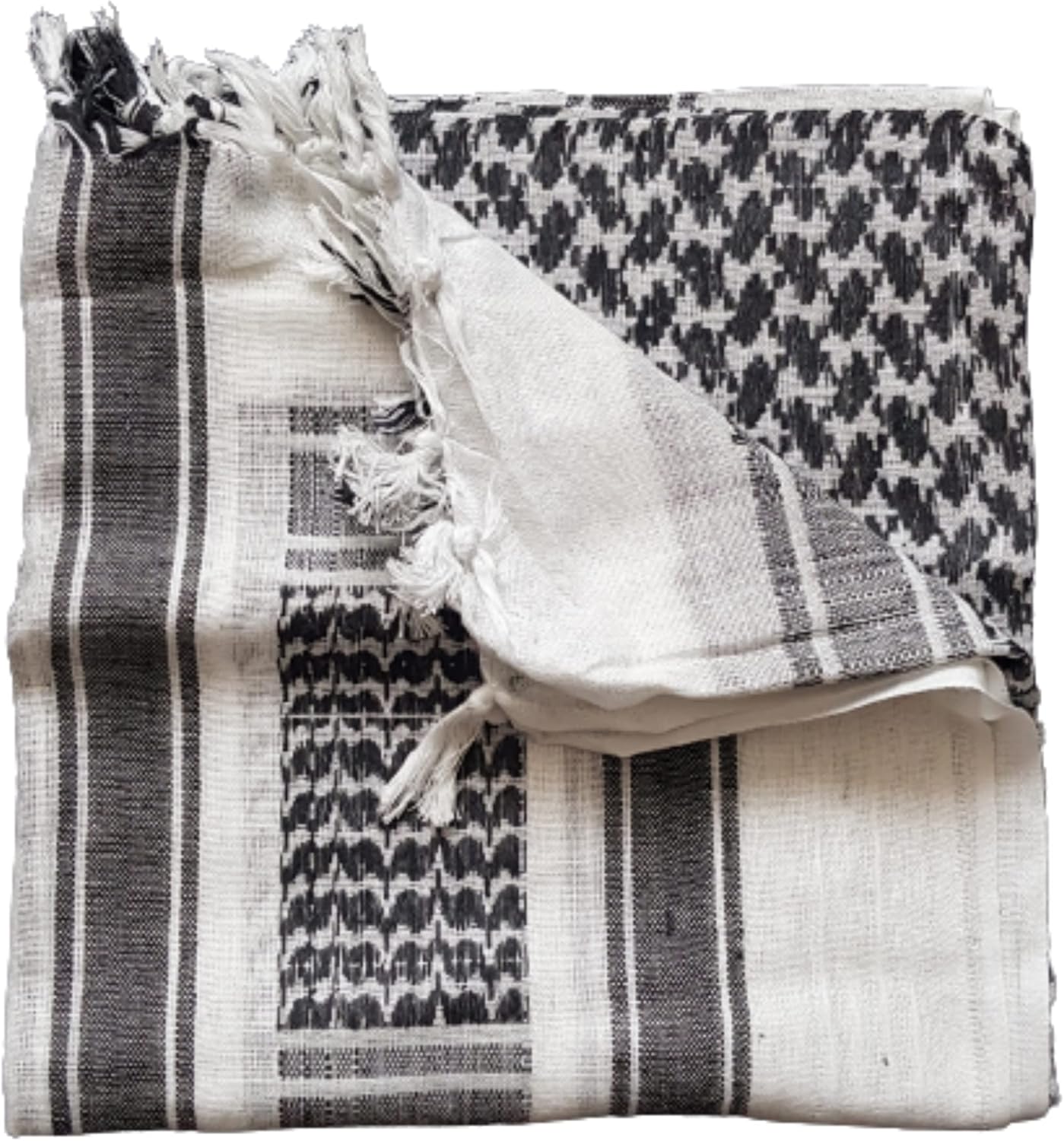
MILSPEC SURPLUS 100% Cotton Black and White Palestinian Shemagh Scarf Arab Keffiyeh Army Military Desert Head Neck Wrap Unisex
FREE Shipping
MILSPEC SURPLUS 100% Cotton Black and White Palestinian Shemagh Scarf Arab Keffiyeh Army Military Desert Head Neck Wrap Unisex
- Brand: Unbranded

Description
Moving forward in history, the keffiya as a head covering was adopted by peasants who wore it while they were working on the land to protect them from the sun, and sand, as well to wipe their faces from the sweat, and in winter to protect them from the rain and cold. Get yourself a Keffiyeh. We have 65+ Styles including the Traditional Arafat Hatta or Palestinian Scarf and the Jordanian Red Hatta. Go to collection. The Keffiyeh's popularity in Palestine Traditionally worn by farmers on the head or shoulders, the kufiya was adopted by freedom fighters in resistance to occupation by the British Empire. The garment easily transitioned to mainstream fashion thereafter. Lingala references a Time Magazine article from 1988 that discusses the Palestinian keffiyeh in American street style and in relation to the first Palestinian intifada, which began in 1987. In Indonesia, some of the people used the keffiyeh to show their solidarity with the Palestinians. [16]
Olives, in all forms - olive oil, olive-oil products (such as soap), and olive wood - were hugely important aspects of Palestinian culinary, social and economic life, Abulhawa explains. Business-wise, it was good timing. Following the establishment of the state of Israel, the period between the late '50s and the '90s was a time of heightened activity for the Palestinian national movement. It was also a period of heightened popularity for its adopted symbol, the keffiyeh. The chequered scarf made it onto newspapers, magazines and TV screens across the world. It has been described by some as "a fishing net, a honeycomb, the joining of hands, or the marks of dirt and sweat wiped off a worker's brow". Others suggest the design represents ears of wheat, in reference to Jericho, one of the first known cities to cultivate the grain. Whether you’re planning a trip to the desert, hiking in the mountains, or simply looking for a stylish and functional accessory to wear around town, a desert scarf can provide a number of benefits.In my opinion, I see no harm in the keffiyeh becoming a fashionable accessory. We see that many artists around the world have put on a keffiyeh in music videos and movies, but it's important that you understand the meaning, and inform your friends and family about the symbolism. The Met supports the right for people to make their voices heard through protest providing it is done lawfully. However, the law also protects people from racist and religious abuse and prohibits the promotion of terrorism,” deputy assistant commissioner Ade Adelekan said on Friday. “While the majority of protesters have complied with these rules, a minority have crossed the line.” Allerton George had not responded to MEE's requests for comment at the time of this article's publication. The posters were torn down and binned, the students were told to remove their badges at the threat of suspension from school and all 'flags and symbols' were removed from sight at the threat of detention."
Increasingly in the 21st century, we seem unable to divorce or decouple football from the wider context." The Bedouin style is similar to the Arab style but with a slight difference in the way the scarf is draped over the head. Over the centuries, the desert scarf has evolved and changed to meet the needs of the people who wear it. When we asked them why it was okay to wear BLM or LGBTQ+ flags on our lanyards but not Palestine, they couldn't give us an answer and later said as a political cause, it caused distress to others.”On a quiet street in Hebron, in the West Bank, down a short driveway and through an unremarkable doorway, I discover the last outpost of an invaluable piece of Palestinian culture. More left-wing members of the Jewish community, which played an active part in the fight against apartheid, have more often held rallies in support of the Palestinian cause.
Jay, a student from Allerton Grange School in Leeds, said she was motivated to put up posters after attending demonstrations and reading stories about child deaths in Gaza. It was publicly launched in the aftermath of the 2005 London bombings and was initially targeted squarely at Muslim communities, prompting continuing complaints of discrimination and concerns that the programme was being used to collect intelligence.
Arafat’s use of the keffiyeh as his permanent head-covering cemented its status as a global icon of Palestinian nationalism and resistance. Guerilla fighters could conceal their identity by wrapping the cloth completely around their face. Having been an exclusively male garment, it was adopted by women, such as the resistance fighter, Leila Khaled, who iconically wore it in headscarf fashion. During the First Intifada (1987) and Second Intifada (2000) it came to be worn worldwide as a symbol of protest and resistance, and solidarity with the Palestinian people. Mural depicting Leila Khaled on the separation wall at Bethlehem, 2018. Courtesy of wikicommons. Add globalisation and a free-market policy adopted often too liberally by the Palestinian Authority (PA), and it is no surprise that Palestinian manufactures have been left with a very small local market indeed. In this climate, cheap Chinese goods flooding into the West Bank and Gaza have been singled out as the most obvious culprit. And thus the keffiyeh became a victim of its own fame.
- Fruugo ID: 258392218-563234582
- EAN: 764486781913
-
Sold by: Fruugo
